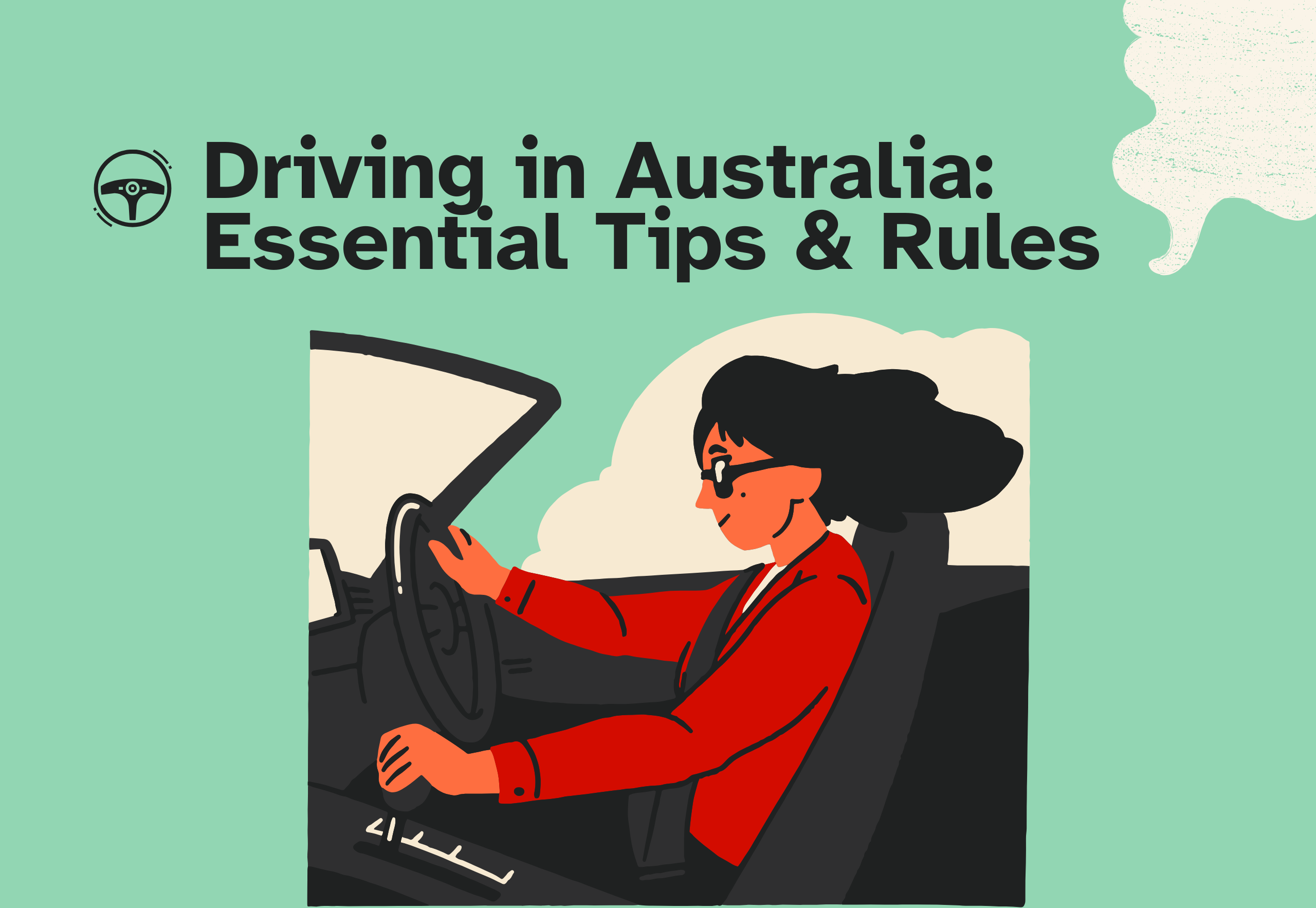Driving Tips in Australia: A Complete Guide for Safe and Smart Driving

Driving in Australia is a unique experience, thanks to its left-side driving rules, strict regulations, and vast, diverse road networks ranging from coastal highways to remote outback tracks. Whether you’re a new driver, a tourist with an international license, or an experienced Aussie motorist, understanding the nuances of driving in Australia can help you stay safe and confident on the roads.
In this comprehensive guide, we’ll cover essential driving tips, from understanding road rules to handling emergencies. So buckle up and let’s hit the road!
1. Understanding Australian Road Rules
1.1 Driving on the Left
One of the most important things to remember when driving in Australia is that all vehicles drive on the left-hand side of the road. This can be confusing for international drivers, especially those from right-hand drive countries, so extra caution is needed at intersections and roundabouts.
1.2 Speed Limits
Speed limits are strictly enforced in Australia and are displayed in kilometres per hour (km/h). General guidelines include:
- Urban areas: 50 km/h unless otherwise signed
- School zones: 40 km/h during specified times
- Rural highways: 100–110 km/h
Fines and demerit points apply for speeding, and mobile speed cameras are widely used.
1.3 Mobile Phone Usage
Using a mobile phone while driving is illegal unless it’s hands-free. Heavy fines and license penalties apply, so it’s best to pull over safely if you need to make a call or send a message.
2. Preparing Your Vehicle
2.1 Regular Maintenance
Always ensure your car is in good working order before driving, especially for long trips. Check:
- Tyre pressure and tread
- Engine oil and coolant levels
- Lights and indicators
- Windscreen wipers and washer fluid
2.2 Emergency Kit
Keep an emergency kit in your vehicle with essentials like:
- First aid kit
- Spare tyre and jack
- Water and non-perishable snacks
- Torch with spare batteries
- Phone charger or power bank
3. Getting Your License
3.1 For Locals
In Australia, the driver licensing process is strict and varies slightly between states. Typically, new drivers go through a graduated system:
- Learner’s Permit (L Plates)
- Probationary License (P1 & P2 Plates)
- Full License
This process involves theory tests, logbook driving hours, and a practical driving test.
3.2 For International Drivers
Visitors can drive with an international license for a limited period, depending on the state. If you become a resident, you’ll need to convert your overseas license to an Australian one, which may involve taking a test.
4. Road Signs and Markings
Australia’s road signs are clear and standardized across all states and territories. Familiar signs include:
- Regulatory signs: Speed limits, stop signs, no entry
- Warning signs: Kangaroo crossing, sharp curves, school zones
- Information signs: Rest stops, distances, fuel stations
It’s important to obey all road signs and markings to avoid fines and ensure safety.
5. Defensive Driving Techniques
Defensive driving is key to preventing accidents, especially in unpredictable environments like rural Australia.
5.1 Maintain Safe Distances
Always keep a safe following distance — the general rule is the 3-second rule, or more in poor weather conditions.
5.2 Be Aware of Wildlife
Kangaroos, wombats, and emus can unexpectedly cross roads, especially at dawn and dusk. Drive cautiously in rural or bush areas and reduce speed if wildlife warning signs are posted.
5.3 Use Headlights Wisely
Use headlights in low visibility and at night. Avoid high beams when other vehicles are approaching.
6. Navigating Different Road Conditions
6.1 Urban Driving
Urban areas are congested, especially during peak hours. Plan ahead, follow traffic lights and signs, and stay alert for pedestrians and cyclists.
6.2 Highway Driving
Highways often have multiple lanes and higher speed limits. Use indicators when changing lanes and always keep left unless overtaking.
6.3 Country and Outback Roads
Driving in remote areas comes with unique challenges:
- Fuel stations are far apart—fill up whenever you can
- Road conditions may vary from paved to gravel
- Always inform someone about your travel plans
7. Parking in Australia
7.1 Parking Signs
Always check for signs before parking. Time limits, permit zones, and no-parking rules vary greatly across cities and suburbs.
7.2 Paid Parking
Many urban areas have paid street parking or council car parks. Use a parking app or pay machine and display your ticket if required.
7.3 Illegal Parking
Don’t park in disabled bays without a permit, on nature strips, or too close to intersections. Fines and towing fees apply for illegal parking.
8. Driving with Kids and Pets
8.1 Child Restraints
Children under seven years must be secured in approved child restraint systems appropriate to their age and size.
8.2 Pets in Cars
Keep pets restrained with a harness or travel crate. Unrestrained pets can cause accidents and attract fines.
9. Fuel and Toll Roads
9.1 Types of Fuel
Most vehicles run on:
- Unleaded petrol (91, 95, 98 RON)
- Diesel
- LPG (less common)
Check your fuel type before filling up.
9.2 Toll Roads
Toll roads operate in cities like Sydney, Brisbane, and Melbourne. Payments are made electronically via an e-tag or online. Non-payment may result in penalties.
10. Road Safety and Penalties
10.1 Random Breath Testing
Australia has strict laws around alcohol and drug use while driving. Random breath tests (RBTs) are common.
- Legal blood alcohol content (BAC) limit is 0.05%
- Learners and probationary drivers must have zero BAC
10.2 Demerit Points System
Each driver has a demerit point limit. Accumulating too many points results in license suspension.
11. Driving Etiquette
11.1 Be Polite
Use indicators, thank drivers who let you in, and don’t tailgate or honk unnecessarily. Courtesy goes a long way.
11.2 Roundabout Rules
Give way to your right when entering a roundabout. Indicate left when exiting.
12. How to Improve Your Driving Skills
Whether you’re a new driver or just want to sharpen your skills, consider professional lessons. For instance, a driving instructor in Pakenham can provide tailored training to boost your confidence on the road.
13. Tips for Long-Distance Driving
13.1 Take Regular Breaks
Follow the “Stop Revive Survive” campaign — take a 15-minute break every two hours.
13.2 Share Driving Duties
If you’re traveling with others, take turns behind the wheel to reduce fatigue.
13.3 Stay Hydrated and Alert
Dehydration can cause fatigue. Drink water regularly and avoid heavy meals.
14. Driving During Holidays and Festivals
Australian roads get busy during public holidays like Christmas and Easter. Plan ahead, allow extra travel time, and drive patiently.
15. Eco-Friendly Driving Tips
- Avoid unnecessary idling
- Keep tyres properly inflated
- Drive at a consistent speed
- Reduce use of air conditioning when possible
Conclusion
Driving in Australia offers the freedom to explore its breathtaking landscapes, but it also comes with responsibilities. From adhering to traffic laws to adjusting to different environments, staying safe requires awareness and preparation. Whether you’re a learner or an experienced motorist, applying these driving tips will ensure a smooth and enjoyable journey.



